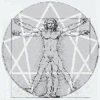“‘Carbon,’ ‘oxygen,’ and ‘nitrogen’ together will give matter of the fourth order, or ‘hydrogen’ (H), whose density we will designate by the number 6 (as the sum of 1, 2, 3), that is, H6: The first TRIAD Fragments: Nine
“But being more active than ‘oxygen’ ‘nitrogen’ enters as the active principle in the next TRIAD and enters with the density of 2. In other words ‘nitrogen’ has a density of 2 and ‘oxygen’ a density of 3. Fragments: Nine
“So that the note la of the first TRIAD is the conductor of the active force in the next TRIAD which it enters with the density of 2. If ‘carbon’ enters with the density of 2, then ‘oxygen’ and ‘nitrogen’ must correspond to it in densities, repeating the ratio of densities of the first TRIAD. In the first TRIAD the ratio of densities was 1, 2, 3; in the second TRIAD it should be 2, 4, 6, that is, ‘carbon’ of the second TRIAD will possess the density of 2, ‘nitrogen’ a density of 4, ‘oxygen’ a density of 6. Taken together they will give ‘hydrogen’ 12 (H12): The second TRIAD Fragments: Nine
“According to the same plan and order the following TRIAD will be constructed: fa, ‘shock,’ mi. ‘Carbon’ which was ‘nitrogen’ in the second TRIAD enters with a density of 4; the ‘nitrogen’ and ‘oxygen’ corresponding to it must have a density of 8 and 12; together they will give ‘hydrogen’ 24 (H24): Fragments: Nine
The third TRIAD Fragments: Nine
“The next TRIAD mi, re, do, by the same plan and order will give ‘hydrogen’ 48 (H48): Fragments: Nine
The fourth TRIAD Fragments: Nine
“The TRIAD do, si, la will give ‘hydrogen’ 96 (H96): Fragments: Nine
The fifth TRIAD Fragments: Nine
the TRIAD la, sol, fa — ‘hydrogen’ 192 (H192): Fragments: Nine
The sixth TRIAD Fragments: Nine
The seventh TRIAD Fragments: Nine
mi, re, do — ‘hydrogen’ 768 (H768): The eighth TRIAD Fragments: Nine
do, si, la — ‘hydrogen’ 1536 (H1536): The ninth TRIAD Fragments: Nine
The tenth TRIAD Fragments: Nine
The eleventh TRIAD Fragments: Nine
mi, re, do — ‘hydrogen’ 12288 (H12288): The twelfth TRIAD Fragments: Nine
‘Re 384 which becomes ‘oxygen’ in the next TRIAD meets with ‘carbon’ 96 in the organism and together with it produces a new ‘nitrogen’ 192 which is the note mi 192. Fragments: Nine
I began to think about the first TRIAD of the ray of creation, about the three forces which made one force. What could they mean? Can we define them? Can we realize their meaning? Something began to formulate itself in my head but just as I tried to translate this into words everything disappeared. — Will, consciousness . . . and what was the third? I asked myself. It seemed to me that if I could name the third I would at once understand everything else. Fragments: Thirteen
“Now further: ‘Nitrogen’ becomes ‘carbon’ for the next TRIAD, but there is no ‘oxygen’ for it and no ‘nitrogen.’ Therefore by condensation it becomes itself ‘hydrogen’ 6144, but it is a dead hydrogen without any possibility of passing into anything further, a ‘hydrogen’ without the Holy Ghost.” Fragments: Sixteen
I ought to say at this point that the “three octaves of radiations” and the “table of hydrogens” derived from them were a stumbling block to us for a long time. The fundamental and the most essential principle of the transition of the TRIADs and the structure of matter I understood only later, and I will speak of it in its proper place. Fragments: Nine
“Among the formulas giving a summary of the content of many symbols there was one which had a particular significance, namely the formula ‘As above, so below,’ from the ‘Emerald Tablets of Hermes Trismegistus.’ This formula stated that all the laws of the cosmos could be found in the atom or in any other phenomenon which exists as something completed according to certain laws. This same meaning was contained in the analogy drawn between the microcosm — man, and the macrocosm — the universe. The fundamental laws of TRIADs and octaves penetrate everything and should be studied simultaneously both in the world and in man. But in relation to himself man is a nearer and a more accessible object of study and knowledge than the world of phenomena outside him. Therefore, in striving towards a knowledge of the universe, man should begin with the study of himself and with the realization of the fundamental laws within him. Fragments: Fourteen

